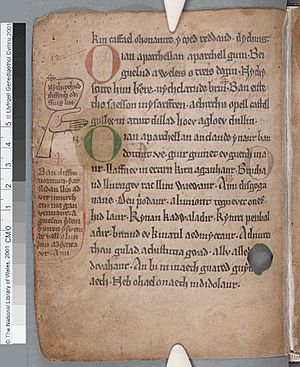Black Book of Carmarthen facts for kids
Quick facts for kids Black Book of Carmarthen |
|
|---|---|
| Peniarth MS 1 | |

f.4.r
|
|
| Also known as | Llyfr Du Caerfyrddin |
| Date | Early to mid 13th century |
| Language(s) | Middle Welsh |
| Scribe(s) | Unknown, believed to be a single scribe |
| Material | Vellum |
| Size | 54 folios (108 pages) |
The Black Book of Carmarthen (Welsh: Llyfr Du Caerfyrddin) is a very old and important book from Wales. It's thought to be the earliest surviving manuscript (a handwritten book) written completely in the Welsh language. This special book was made around the middle of the 13th century, which means it's about 750 years old!
It gets its name from a place called the Carmarthen Priory and its dark cover. Today, you can find it at the National Library of Wales, where it is kept safe. This book was once part of a large collection owned by Robert Vaughan, a Welsh historian, in a mansion called Hengwrt. Later, his collection, including the Black Book, went to the newly formed National Library of Wales.
It is believed that the book was first recorded when it came into the hands of Sir John Price in the 1500s. He was working to find books from monasteries that were being closed down by King Henry VIII. The book was given to him by a church leader from St David's Cathedral, who had received it from Carmarthen Priory. The Black Book is known as one of the "Four Ancient Books of Wales."
What is the Black Book of Carmarthen?
This ancient book was written before the year 1250. It is a small book, about the size of a modern paperback, and is made of vellum (a type of parchment made from animal skin). The book has 54 folios, which means 108 pages. Some pages are missing, so it's not a complete book.
One person wrote the entire book. However, the handwriting changes a bit throughout the book. This suggests that the writer might have worked on it over a long time. The first pages have large, clear writing, while later pages have smaller, more cramped writing.
What's Inside the Black Book?
The Black Book of Carmarthen contains a collection of old Welsh poems. These poems were written between the 9th and 12th centuries. They cover many different topics, like religious stories, everyday life, and poems praising or mourning people.
Some of the most interesting poems are about famous Welsh heroes. These include stories connected to the legend of King Arthur and Myrddin, who is known as Merlin in later stories. These poems about Merlin are even older than the descriptions of him by a writer named Geoffrey of Monmouth!
One poem, called The Elegy of Gereint son of Erbin, talks about a battle where Arthur was involved. Other poems, like Yr Afallennau and Yr Oianau, describe a mad Merlin in a forest. He talks to an apple tree and a pig, making predictions about battles between the Welsh army and the Normans.
Here are some other poems found in the book:
- Ymddiddan Myrddin a Thaliesin (A Conversation Between Merlin and Taliesin)
- Dadl y Corff a'r Enaid (Dialogue between the Body and the Soul)
- Elegy to Madog ap Maredudd (a poem mourning Madog ap Maredudd, who died in 1160)
- The Elegy of Gereint son of Erbin
- The Verses of the Graves
- Kyntaw geir (a poem about going on a pilgrimage and asking for forgiveness)
Discoveries and Modern Use
In 2002, the Black Book was scanned and made available online. This means people all over the world can now see its pages!
More recently, in 2015, experts from the University of Cambridge used special imaging tools, like ultraviolet lamps and photo-editing software. These tools helped them see things that were invisible before! They found hidden notes in the margins, including a message that suggests the book was a gift from one family member to another. They also found drawings of a fish and two human faces, and even a Welsh poem that no one knew about before. These new discoveries help us learn even more about this amazing old book.


